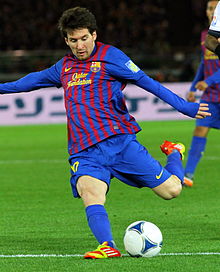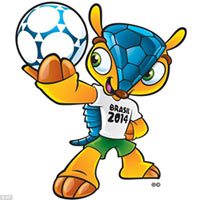 Often heralded as one of the best, if not the best, soccer player in the world, Lionel Andrés “Leo” Messi currently plays forward for FC Barcelona and serves as the captain of the Argentina National Team. Messi was born on June 24th, 1987 in Rosario, Argentina, the largest city in the province of Santa Fe in central Argentina, to parents Jorge Horacio Messi and Celia Maria Cuccittini. He is the third of four children with two older brothers, Rodrigo and Matias, and a sister, Maria Sol.
Often heralded as one of the best, if not the best, soccer player in the world, Lionel Andrés “Leo” Messi currently plays forward for FC Barcelona and serves as the captain of the Argentina National Team. Messi was born on June 24th, 1987 in Rosario, Argentina, the largest city in the province of Santa Fe in central Argentina, to parents Jorge Horacio Messi and Celia Maria Cuccittini. He is the third of four children with two older brothers, Rodrigo and Matias, and a sister, Maria Sol.
Messi’s career as a soccer player began at the early age of five when he started playing soccer for Grandoli, which was a local soccer club coached by his father. After two years of playing for Grandoli, Messi switched to a team in his home city of Rosario, the Newell’s Old Boys. As a member of the Newell’s Old Boys (Who became known as “The Machine of ‘87”) the team lost only one soccer match over four years. Messi’s early career as a soccer player came to a fork in the road when he turned 11 and was diagnosed with a growth hormone deficiency. After learning about his talent, Carles Rexach offered Messi a tryout for FC Barcelona and ultimately agreed to cover Messi’s medical bills for treatment of his growth hormone deficiency.
From 2000 to 2003, Messi continued to develop as a young prospect as a team member of the FC Barecelona’s Junior Infantile B and Cadet B & A. Messi continued to work his way from FC Barecelona’s Juvenil B, to Juvenil A, to FC Barelona C team, then B. At the age of 16, Messi started his first game with the club in a friendly soccer match between Barcelona and Porto. Within a year of his first start he made his official league debut in a match against RCD Espanyol becoming the third youngest player to ever make a start for FC Barcelona. His first goal came against Albacete Balompie and earned him the record of the youngest player to score a goal for FC Barcelona in a La Liga game. (Which was later broken by Bojan Krkic, who scored from a Messi assist) Messi continued to play for FC Barecelona, and as of 2013 is still an active member of the club.
Messi’s style of play is characterized by a low center of gravity which allows him to be more agile than most players. He is notably a strong finisher with great pace, dribbling, balance and passing ability. Messi is dominantly a left footed soccer player and his short, strong legs enable bursts of speed coupled with his quick feet giving him the ability to maintain great ball control even at full speed. It’s almost like the ball stays glued to his foot even when running at full speed, having possibly the best ball control skills of any player.
Lionel Messi has an accomplished list of awards that he has won throughout his years as a soccer player, including:
As a member of FC Barcelona he has won the La Liga 5 times, the Copa del Ray 2 times, the Supercopa de Espana 5 times, the UEFA Champions League 3 times, the UEFA Super Cup twice and the FIFA Club World Cup twice.
As a Member of the Argentia National Team he has won an Olympic gold medal in 2008 and the FIFA U-20 World Cup in 2005. He was runner up in the 2007 Copa America and placed third in the U20 South American Youth Championship in 2005.
Some of the Individual soccer awards that he was won throughout his career include: the FIFA Balloon d’Or 3 times, the Ballon d’Or 1 time, FIFA player of the year 1 time, World soccer young player of the year 3 times, World soccer player of the year 3 times, the Onze d’Or 3 times, the IFFHS Worlds top goal scorer twice, the IFFHS Worlds best top division goal scorer once, the Goal.com Player of the Year soccer award twice, El Pais King of European soccer 4 times, the ESPY Best International Athlete once, the European Golden Shoe twice, the UEFA Best soccer player in Europe award 1 time, the UEFA Club Footballer of the year award once, the UEFA Team of the year award 5 times and the European Golden Boy award once.
At only 25 years old, Messi has won many different cups, set many different records and continues to amaze people both on and off the field. Lionel Messi is certainly a player to keep your eye on in the years to come as he continues to develop as a player.
Here is a great soccer video documenting some of the more incredible soccer plays that Lionel Messi has ever made.
 The official mascot for the 2014 FIFA World Cup is Fuleco the Armadillo – As pictured to the left. The voting process for the official 2014 World Cup Mascot was a three month long campaign that was supported by Coca-Cola. Fuleco won the voting with 48% of the vote followed by Zuzeco with 31% of the vote and Amijubi with 21% of the vote, making Fuleco the unanimous winner. One of the most important themes of the 2014 FIFA World Cup is the importance of the environment and ecology. As an Armadillo, which is a vulnerable species, the name Fuleco is a combination of the words “futebol” and “ecologia”. This combination is intended to communicate the importance of behaving in an environmentally friendly manner. (For more information about Fuleco, visit http://mascot.fifa.com/about.php)
The official mascot for the 2014 FIFA World Cup is Fuleco the Armadillo – As pictured to the left. The voting process for the official 2014 World Cup Mascot was a three month long campaign that was supported by Coca-Cola. Fuleco won the voting with 48% of the vote followed by Zuzeco with 31% of the vote and Amijubi with 21% of the vote, making Fuleco the unanimous winner. One of the most important themes of the 2014 FIFA World Cup is the importance of the environment and ecology. As an Armadillo, which is a vulnerable species, the name Fuleco is a combination of the words “futebol” and “ecologia”. This combination is intended to communicate the importance of behaving in an environmentally friendly manner. (For more information about Fuleco, visit http://mascot.fifa.com/about.php)
 Detroit native Norman Koza, whose love for film got his experience from making his first feature.
Detroit native Norman Koza, whose love for film got his experience from making his first feature. BBA-Banking & Finance from University of Michigan. Lance has written 30 screenplays and directed 4 features.
BBA-Banking & Finance from University of Michigan. Lance has written 30 screenplays and directed 4 features. Email Us
Email Us